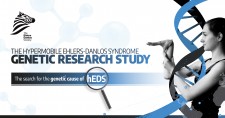The Ehlers-Danlos Society Announces Worldwide Research Study to Identify the Genetic Cause of Hypermobile Ehlers-Danlos Syndrome

Baltimore, MD, March 8, 2019 (Newswire.com) - The Ehlers-Danlos Society is excited to announce the start of recruitment for participants in the Hypermobile Ehlers-Danlos Syndrome Genetic Research Study, devoted to finding the underlying genetic markers for hypermobile EDS (hEDS).
Since the announcement of the extraordinary “Moonshot” donation in early 2018, which was then followed by a generous matching donation in early 2019, The Ehlers-Danlos Society brought together an international group of physicians, geneticists, and technical staff to form the Hypermobile EDS Genetic Research Network, dedicated to finding the genetic cause, or causes of hEDS. Of the 14 subtypes of the group of connective tissue disorders known collectively as the Ehlers-Danlos syndromes (EDS), only the hypermobile type does not yet have an identified genetic marker. It is also the most common form of EDS.
“To find preventions and treatments for hEDS, we have to understand the cause. Genetic studies like this one provide a path towards that goal,” said Joel Hirschhorn, MD, PhD, Concordia Professor of Pediatrics and Professor of Genetics at Boston Children’s Hospital/Harvard Medical School and member of the Hypermobile Genetic Research Network.
Over the next nine months, The Ehlers-Danlos Society will recruit, screen, and genetically sequence 1000 individuals who have been diagnosed with hypermobile EDS, according to the most recent clinical criteria established in 2017.
The Hypermobile Ehlers-Danlos Syndrome Genetic Study would not be possible without the EDS and Related Disorders Global Registry, another ambitious worldwide research effort spearheaded by The Ehlers-Danlos Society. Launched in July of 2018, the Global Registry is a collection of standardized health information provided by thousands of patients with all forms of EDS and hypermobility spectrum disorders (HSD), allowing researchers to compare and analyze patient data on a much larger scale than possible in individual research studies alone. The Registry has the potential to unlock countless discoveries about all forms of EDS and HSD and lays the groundwork for large-scale research efforts like the Hypermobile Ehlers-Danlos Syndrome Genetic Study. All potential study participants must first join the Global Registry.
The first enrollment events will take place at The Ehlers-Danlos Society European Learning Conference in Madrid, Spain, in April 2019, and the Learning Conference in Nashville, Tennessee, USA, in July 2019. Throughout the year, the Society will also be working with selected clinicians around the world to invite their qualifying patients who have completed the Global Registry to take part in the study.
“Understanding the genetic causes of hypermobile EDS is absolutely crucial to the EDS community,” said Clair Francomano, MD, chair of The Ehlers-Danlos Society’s Medical and Scientific Board, Director of The Ehlers-Danlos Society Center for Clinical Care and Research at the Harvey Institute of Human Genetics in Baltimore, MD, and a member of the Hypermobile Genetic Research Network. “It will allow us to make unequivocal diagnoses, for one thing. Further, understanding the genetic pathways leading to hypermobile EDS will inform the search for rational therapies for this disorder, and hopefully, eventually, a cure.”
“If we are successful in identifying the underlying genes for hypermobile EDS, the opportunities for earlier diagnosis and more comprehensive treatment and care are virtually limitless,” stated Lara Bloom, International Executive Director for The Ehlers-Danlos Society. “We are incredibly grateful to the generous donors who’ve made this possible.”
For more information about this study, including how to get participate, please visit the Hypermobile EDS Genetic Research Study.
ABOUT THE EHLERS-DANLOS SYNDROMES AND HYPERMOBILITY SPECTRUM DISORDERS
The Ehlers-Danlos syndromes (EDS) are a group of 14 heritable connective tissue gene disorders that produce a spectrum of complex problems across multiple systems of the body. The physical characteristics that are common to all types of EDS include hypermobile joints, skin hyperextensibility, and tissue fragility. EDS is known to affect more than one in 5,000 men and women of every race and ethnicity. Each person’s case of Ehlers-Danlos syndrome is unique. Severity may range dramatically, even within families. Prognosis depends on the type of Ehlers-Danlos syndrome and the individual.
Hypermobile Ehlers-Danlos Syndrome (hEDS)
Hypermobile EDS (hEDS) typically begins with extreme joint hypermobility, joints which can stretch beyond normal limits; a propensity for sprains, strains, subluxations and dislocations; pain, often in lower limbs, and with fine motor or repetitive tasks; and easy fatigability. Although each person with hEDS faces their own set of problems out of the wide range of possible effects, hEDS generally evolves. The initial “hypermobility” phase may involve the ability to hyperextend various body parts to extremes normally attributed to contortionists, gymnasts or elite dancers. Over time, the extreme hypermobility and connective tissue instability of hypermobile EDS may lead to permanent injuries. The “pain” phase involves widespread and worsening pain and headache; pelvic pain in women; and worsened fatigue. The “stiffness” phase seen in some adults and in the elderly results in general reduction in joint hypermobility; significant losses in functionality because of disabling pain and fatigue; and increased limitations, due to reduced muscle mass and weakness, prior injuries and arthritis. While certain features of hypermobile EDS are not yet in the diagnostic criteria — as more research is needed to prove causation and the relationships between the hEDS and potential comorbidities — clinical descriptions of hEDS have expanded beyond joint hypermobility to include: chronic pain and fatigue, gastrointestinal disorders, neurological issues, dysautonomia, and anxiety. As of this time, hypermobile EDS has no identified distinctive cause.
Hypermobility Spectrum Disorders (HSD)
The hypermobility spectrum disorders (HSD) describe patients with symptomatic joint hypermobility not corresponding to other known conditions. The spectrum of HSD ranges from secondary musculoskeletal manifestations and a simplified categorization of genetic syndromes featuring joint hypermobility.
ABOUT THE EHLERS-DANLOS SOCIETY
The Ehlers-Danlos Society is a global community of patients, caregivers, health care professionals, and supporters, dedicated to saving and improving the lives of those affected by the Ehlers-Danlos syndromes. Headquartered in Baltimore, MD, The Ehlers-Danlos Society is a registered 501c3 nonprofit organization in the United States and a registered charity in the United Kingdom.
Source: The Ehlers-Danlos Society
